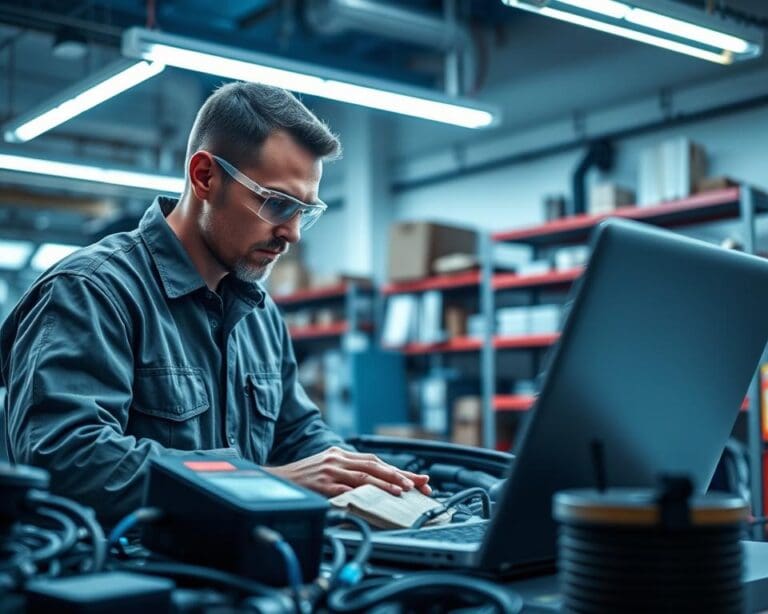As the world shifts towards more sustainable practices, the concept of circular production is gaining significant attention. Circular production aims to reduce waste and the continuous consumption of resources by promoting the reuse and recycling of products. Embracing this approach can significantly reduce environmental impact.
The integration of Artificial Intelligence (AI) in circular production is being explored for its potential to enhance sustainability. AI can help optimize production processes, predict maintenance needs, and improve product design for recyclability and reuse. By leveraging AI, businesses can make significant strides in reducing their environmental footprint.
Key Takeaways
- The role of AI in enhancing circular production practices.
- How AI can help overcome challenges in circular production.
- The potential benefits of integrating AI in sustainable production processes.
- The impact of AI on product design for recyclability and reuse.
- The future of circular production with AI-driven solutions.
The Evolution of Circular Production
The evolution of circular production is a critical response to the environmental challenges posed by traditional linear production models. As the global economy continues to grow, the need to adopt more sustainable practices becomes increasingly important.
Circular production is rooted in the principles of the circular economy, which aims to reduce waste and the consumption of resources by promoting the reuse and recycling of products. This approach not only helps in minimizing environmental impacts but also offers economic benefits through cost savings and the creation of new revenue streams.
Defining Circular Economy Principles
The circular economy is based on three key principles: reduce, reuse, and recycle. By designing products and processes that are restorative and regenerative by design, businesses can significantly reduce their environmental footprint. AI technology plays a crucial role in this process by enabling companies to analyze data, predict outcomes, and make informed decisions that support circular economy principles.
The Urgent Shift from Linear to Circular Models
The traditional linear economy model, which is based on a take-make-dispose approach, is no longer sustainable. The urgent shift towards circular models is driven by the need to mitigate the environmental impacts of production, such as resource depletion and pollution. Innovations in circular production with AI are facilitating this shift by optimizing production processes, improving supply chain management, and enabling the creation of more sustainable products.
Current Challenges in Achieving Circularity
Several barriers stand in the way of widespread adoption of circular production methods. Despite the growing interest in circular economy principles, significant challenges need to be overcome to achieve a more sustainable and circular production system.
The first major hurdle is related to resource tracking and management. Effective circular production requires precise monitoring and management of resources throughout the entire production lifecycle. However, current systems often lack the necessary visibility and transparency, making it difficult to track materials and products efficiently.
Resource Tracking and Management Issues
One of the primary issues in resource tracking is the lack of standardized systems for monitoring and managing resources. This results in inefficiencies and inaccuracies, hindering the ability to make informed decisions. As Ellen MacArthur, a renowned advocate for the circular economy, once said, “A circular economy is restorative and regenerative by design, and it aims to keep products, components, and materials at their highest utility and value at all times.”
“A circular economy is about keeping products and materials in circulation for as long as possible.”
Achieving this requires robust tracking and management systems.
Design and Manufacturing Limitations
Another significant challenge lies in the design and manufacturing stages. Current design and manufacturing practices often prioritize cost and efficiency over sustainability, resulting in products that are difficult to recycle or reuse. AI solutions for circular manufacturing can help address these limitations by optimizing design processes and enabling the creation of more sustainable products.
By understanding and addressing these challenges, we can begin to develop effective strategies for achieving circularity in production. The benefits of AI in the circular economy are substantial, and leveraging AI technologies can play a crucial role in overcoming the current challenges.
Kan AI bijdragen aan circulaire productie?
The integration of Artificial Intelligence (AI) in production processes is revolutionizing the way companies approach circular economy principles. By analyzing vast amounts of data, AI can help businesses identify opportunities to reduce waste, optimize production processes, and design more sustainable products.
“AI is not just a tool for automation; it’s a catalyst for circular transformation,” says a recent industry report. This transformation is crucial as companies worldwide face increasing pressure to adopt sustainable practices.
The Fundamental Role of AI in Circular Systems
AI plays a fundamental role in circular systems by enabling companies to make data-driven decisions. Through machine learning algorithms and predictive analytics, AI can forecast demand, detect potential bottlenecks in production, and suggest optimizations to reduce waste.
For instance, AI can analyze production data to identify patterns that may lead to waste. By predicting and preventing such waste, companies can significantly reduce their environmental footprint.
Key benefits of AI in circular systems include:
- Enhanced predictive maintenance
- Optimized resource allocation
- Improved product design for recyclability
AI as an Enabler for Circular Transformation
AI acts as a significant enabler for circular transformation by providing insights that help companies transition from linear to circular business models. It does so by analyzing market trends, consumer behavior, and production data to identify opportunities for circular innovation.
For example, AI can help companies design products that are not only recyclable but also made from recycled materials, thereby closing the loop in the production cycle.
“The future of production lies in embracing circular economy principles, and AI is at the forefront of this revolution.”
By integrating AI into their operations, businesses can not only reduce their environmental impact but also create new revenue streams through circular business models.
AI Technologies Driving Circular Innovation
AI is playing a crucial role in driving circular innovation across various industries. The integration of AI technologies is transforming the way companies approach production, making it more sustainable and efficient. By leveraging AI, businesses can significantly reduce waste and improve resource utilization.
Machine Learning for Material Identification
Machine learning, a subset of AI, is being utilized for material identification. This technology enables the accurate classification of materials, which is crucial for recycling and reusing. By identifying materials correctly, companies can ensure that they are processed appropriately, reducing contamination and increasing the quality of recyclables.
Computer Vision in Sorting and Recycling
Computer vision is another AI technology that is making a significant impact in sorting and recycling. By using cameras and machine learning algorithms, computer vision systems can identify and sort materials with high precision. This not only improves the efficiency of recycling processes but also enhances the quality of the materials recovered.
Predictive Analytics for Product Lifecycle Management
Predictive analytics is being used to manage product lifecycles more effectively. By analyzing data on product usage and performance, companies can predict when products are likely to fail or need replacement. This enables proactive maintenance and reduces waste by ensuring that products are not discarded unnecessarily.
The application of these AI technologies is driving innovations in circular production, enabling companies to adopt more sustainable practices. As AI continues to evolve, its role in promoting circularity in production is expected to grow, leading to more efficient and sustainable production processes.
Smart Design and Manufacturing with AI
The integration of AI in design and manufacturing is revolutionizing the way companies approach circular production. By applying AI-powered design principles, businesses can create products that are easier to disassemble and reuse, reducing waste and promoting the recovery of valuable materials.
AI-Powered Design for Disassembly and Reuse
AI is enabling companies to design products with circular economy principles in mind. For instance, AI algorithms can analyze product designs and suggest modifications that make them easier to disassemble and recycle. This not only reduces waste but also enhances the recovery of valuable materials. Companies like Patagonia are already using AI to design products with recycled materials and to optimize their supply chains for sustainability.
Optimizing Production Processes for Minimal Waste
AI is also being used to optimize production processes, minimizing waste and reducing the environmental footprint of manufacturing. By analyzing production data, AI can identify areas of inefficiency and suggest improvements. For example, AI can optimize cutting patterns in textile manufacturing to reduce fabric waste or predict maintenance needs for machinery, reducing downtime and waste.
| Industry | AI Application | Benefit |
|---|---|---|
| Textile Manufacturing | Optimized cutting patterns | Reduced fabric waste |
| Product Design | Design for disassembly | Enhanced material recovery |
| Machinery Maintenance | Predictive maintenance | Reduced downtime and waste |
Supply Chain Optimization Through AI
AI technology is being increasingly adopted to optimize supply chains, making them more efficient and sustainable. By integrating AI into supply chain management, companies can better predict demand, manage inventory, and streamline logistics. This not only reduces costs but also enhances customer satisfaction by ensuring timely deliveries.
Tracking Materials with Blockchain and AI Integration
The combination of AI and blockchain technology is revolutionizing material tracking in supply chains. Blockchain provides a secure and transparent ledger for recording transactions, while AI analyzes this data to predict potential disruptions and optimize material flow. This integration helps in reducing counterfeiting, improving supply chain visibility, and ensuring compliance with regulations.
Reducing Waste in Distribution Networks
AI plays a crucial role in minimizing waste within distribution networks. By analyzing data on consumer demand, transportation logistics, and inventory levels, AI systems can optimize routing and scheduling, reducing unnecessary mileage and lowering emissions. Furthermore, AI-driven predictive analytics help in identifying potential bottlenecks, enabling proactive measures to mitigate waste and improve overall efficiency.
AI-Driven Waste Management Solutions
As the world moves towards a more circular economy, AI’s role in waste management becomes increasingly crucial. The integration of AI technologies in waste management is not only reducing waste but also recovering valuable materials that can be reused, thereby promoting a more circular and sustainable production process.
Smart Sorting Systems and Robotics
AI is enhancing waste management through smart sorting systems and robotics. These technologies are capable of identifying and sorting materials with high precision, significantly improving the efficiency of recycling processes.
Optical Sorting Technologies
Optical sorting technologies utilize AI-powered computer vision to identify and sort materials based on their composition. This technology is particularly effective in sorting plastics, metals, and other materials that are commonly found in household and industrial waste.
Robotic Disassembly Systems
Robotic disassembly systems are designed to dismantle products into their component parts, allowing for the recovery of valuable materials. These systems are equipped with AI algorithms that enable them to adapt to different product designs and configurations.
Waste-to-Resource Conversion Technologies
AI is also being used to develop waste-to-resource conversion technologies that can transform waste materials into valuable resources. These technologies have the potential to significantly reduce waste disposal costs and generate new revenue streams.
By leveraging AI-driven waste management solutions, industries can not only reduce their environmental footprint but also improve their bottom line. As AI continues to evolve, we can expect to see even more innovative applications in waste management and circular production.
Case Studies: AI Success Stories in Circular Production
The integration of AI in circular production has led to significant breakthroughs in various industries. By harnessing the power of AI, companies are not only reducing waste but also enhancing their sustainability credentials. This section highlights some notable case studies where AI has been successfully implemented to drive circular economy principles.
Manufacturing Sector Implementations
The manufacturing sector has seen substantial benefits from AI adoption in circular production. Companies are leveraging AI to optimize their production processes, reduce material waste, and improve recycling rates.
Apple’s Recycling Robot Daisy
Apple’s innovative recycling robot, Daisy, is a prime example of AI in action. Daisy can disassemble up to 200 iPhones per hour, extracting valuable components for reuse. This not only reduces electronic waste but also recovers precious materials, contributing to a more circular economy.
Siemens’ Smart Factory Solutions
Siemens is another pioneer, utilizing AI to create smart factories that optimize production and minimize waste. Their solutions enable real-time monitoring and adjustments, ensuring that manufacturing processes are as efficient and sustainable as possible.
Retail and Consumer Goods Applications
In the retail and consumer goods sector, AI is being used to drive circular economy practices through innovative product design, packaging optimization, and end-of-life product management. Companies are using AI to analyze consumer behavior and preferences, enabling them to create more sustainable products and packaging.
For instance, some retailers are using AI to design products that are easier to recycle or reuse, reducing waste and the environmental impact of their products. This circular economy optimization through AI is not only beneficial for the environment but also offers cost savings and new revenue streams for businesses.
Economic Benefits of AI in Circular Systems
The economic benefits of integrating AI in circular systems are multifaceted, ranging from cost savings to new revenue streams. As companies adopt AI technologies, they can significantly enhance their production processes, leading to improved efficiency and reduced waste.
Cost savings are a significant advantage. AI can help businesses reduce energy consumption, minimize waste, and optimize resource utilization. For instance, AI-powered predictive maintenance can prevent equipment failures, reducing downtime and maintenance costs.
Cost Savings and New Revenue Streams
AI-driven innovations can also create new revenue streams. Companies can develop new products or services based on data insights generated by AI. For example, AI can help manufacturers identify opportunities for product-as-a-service models, generating recurring revenue.
According to a report, companies that adopt circular economy practices can see a reduction in costs by up to 20% and an increase in revenue by up to 15%. This is supported by companies like Patagonia, which has successfully implemented circular economy practices, reducing waste and increasing customer loyalty.
Long-term Economic Sustainability Models
Long-term economic sustainability is another key benefit. AI can help businesses develop sustainable models that balance economic growth with environmental stewardship. By adopting AI-driven circular economy practices, companies can ensure long-term viability and resilience.
As
“The future of production is not just about being more efficient, it’s about being more circular.”
This highlights the importance of integrating AI in circular systems for long-term economic sustainability.
Environmental Impact of AI-Enhanced Circularity
AI-driven innovations are at the forefront of reducing the ecological footprint of production processes. The integration of AI in circular production systems is not only a technological advancement but also a crucial step towards achieving environmental sustainability.
Reduction in Resource Consumption
One of the significant benefits of AI-enhanced circularity is the reduction in resource consumption. AI technologies can optimize production processes to minimize waste and reduce the use of raw materials. For instance, AI-powered predictive analytics can forecast demand more accurately, thereby reducing overproduction and the associated waste.
- AI optimizes production to meet actual demand, reducing surplus production.
- Predictive maintenance enabled by AI reduces downtime and extends the life of machinery.
- AI-driven material identification helps in recycling and reusing materials more efficiently.
Lowering Carbon Footprints Through Optimized Processes
AI-enhanced circularity also plays a crucial role in lowering carbon footprints. By optimizing production processes and supply chains, AI can significantly reduce greenhouse gas emissions. For example, AI can optimize routes for transportation, reducing fuel consumption and lowering emissions.
- AI optimizes logistics and transportation, reducing fuel consumption.
- Energy consumption is minimized through AI-driven efficiency measures in manufacturing.
- AI helps in designing products that are not only recyclable but also made from recycled materials, further reducing the carbon footprint.
By embracing AI-enhanced circularity, businesses can not only contribute to environmental sustainability but also achieve cost savings and new revenue streams. The environmental benefits of AI in circular economy models are multifaceted, making it a vital component of modern production processes.
Overcoming Challenges in AI Implementation for Circularity
The path to achieving circularity through AI is fraught with technical and ethical challenges. As industries increasingly adopt circular production methods, understanding and addressing these challenges is crucial for successful AI integration.
Technical Barriers and Solutions
One of the primary technical barriers is the complexity of data required for training AI models. High-quality data is essential for accurate material identification, predictive maintenance, and optimizing production processes. To overcome this, companies can invest in data collection and management systems that ensure data accuracy and integrity.
Another significant challenge is the integration of AI with existing infrastructure. This can be addressed through:
- Modular AI solutions that can be easily integrated with legacy systems.
- Collaboration between AI developers and industry experts to design compatible systems.
| Technical Barrier | Solution |
|---|---|
| Data Quality Issues | Implement robust data management systems |
| Infrastructure Compatibility | Use modular AI solutions and collaborate with industry experts |
Ethical Considerations and Responsible AI Development
AI implementation in circular production also raises ethical considerations, such as job displacement and data privacy concerns. To mitigate these issues, it’s essential to develop responsible AI that prioritizes transparency and fairness.
Companies should:
- Invest in workforce retraining programs to prepare employees for an AI-driven environment.
- Implement robust data protection measures to safeguard sensitive information.
By addressing both the technical and ethical challenges, industries can harness the full potential of AI to drive circular production, leading to a more sustainable and efficient future.
Conclusion: The Future of AI in Circular Production
As explored throughout this article, AI has the potential to significantly contribute to circular production, driving sustainability and reducing waste. The integration of Artificial intelligence and circular production can revolutionize the way we design, manufacture, and consume products.
The application of AI in circular systems enables companies to optimize production processes, reduce material waste, and promote the reuse and recycling of products. By leveraging machine learning, computer vision, and predictive analytics, businesses can make data-driven decisions that support a more circular economy.
The question remains, “Kan AI bijdragen aan circulaire productie?” The answer is clear: AI can play a vital role in driving circular innovation and reducing environmental impact. As technology continues to evolve, we can expect to see even more effective solutions emerge, enabling a more sustainable future for industries and consumers alike.









